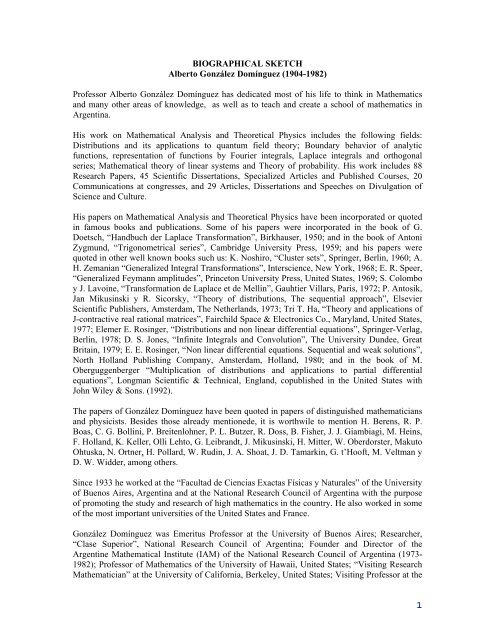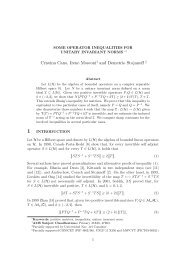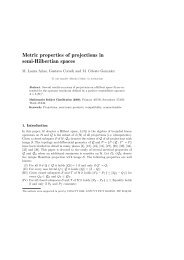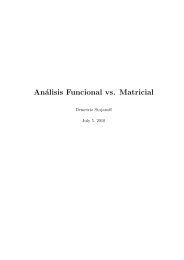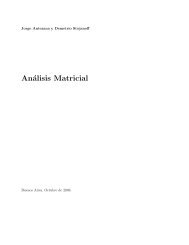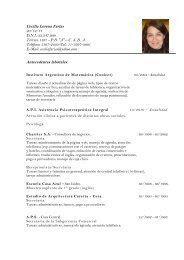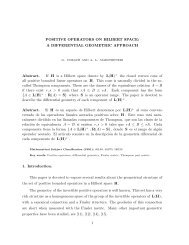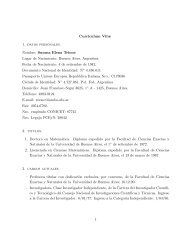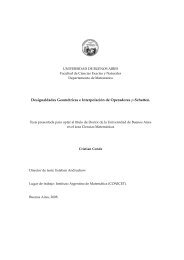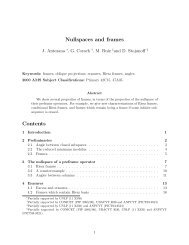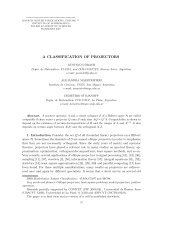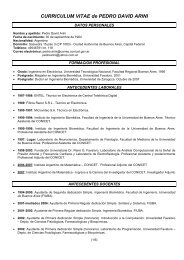BIOGRAPHICAL SKETCH Alberto González DomÃnguez (1904 ... - IAM
BIOGRAPHICAL SKETCH Alberto González DomÃnguez (1904 ... - IAM
BIOGRAPHICAL SKETCH Alberto González DomÃnguez (1904 ... - IAM
Create successful ePaper yourself
Turn your PDF publications into a flip-book with our unique Google optimized e-Paper software.
<strong>BIOGRAPHICAL</strong> <strong>SKETCH</strong><br />
<strong>Alberto</strong> González Domínguez (<strong>1904</strong>-1982)<br />
Professor <strong>Alberto</strong> González Domínguez has dedicated most of his life to think in Mathematics<br />
and many other areas of knowledge, as well as to teach and create a school of mathematics in<br />
Argentina.<br />
His work on Mathematical Analysis and Theoretical Physics includes the following fields:<br />
Distributions and its applications to quantum field theory; Boundary behavior of analytic<br />
functions, representation of functions by Fourier integrals, Laplace integrals and orthogonal<br />
series; Mathematical theory of linear systems and Theory of probability. His work includes 88<br />
Research Papers, 45 Scientific Dissertations, Specialized Articles and Published Courses, 20<br />
Communications at congresses, and 29 Articles, Dissertations and Speeches on Divulgation of<br />
Science and Culture.<br />
His papers on Mathematical Analysis and Theoretical Physics have been incorporated or quoted<br />
in famous books and publications. Some of his papers were incorporated in the book of G.<br />
Doetsch, “Handbuch der Laplace Transformation”, Birkhauser, 1950; and in the book of Antoni<br />
Zygmund, “Trigonometrical series”, Cambridge University Press, 1959; and his papers were<br />
quoted in other well known books such us: K. Noshiro, “Cluster sets”, Springer, Berlin, 1960; A.<br />
H. Zemanian “Generalized Integral Transformations”, Interscience, New York, 1968; E. R. Speer,<br />
“Generalized Feymann amplitudes”, Princeton University Press, United States, 1969; S. Colombo<br />
y J. Lavoine, “Transformation de Laplace et de Mellin”, Gauhtier Villars, Paris, 1972; P. Antosik,<br />
Jan Mikusinski y R. Sicorsky, “Theory of distributions, The sequential approach”, Elsevier<br />
Scientific Publishers, Amsterdam, The Netherlands, 1973; Tri T. Ha, “Theory and applications of<br />
J-contractive real rational matrices”, Fairchild Space & Electronics Co., Maryland, United States,<br />
1977; Elemer E. Rosinger, “Distributions and non linear differential equations”, Springer-Verlag,<br />
Berlin, 1978; D. S. Jones, “Infinite Integrals and Convolution”, The University Dundee, Great<br />
Britain, 1979; E. E. Rosinger, “Non linear differential equations. Sequential and weak solutions”,<br />
North Holland Publishing Company, Amsterdam, Holland, 1980; and in the book of M.<br />
Oberguggenberger “Multiplication of distributions and applications to partial differential<br />
equations”, Longman Scientific & Technical, England, copublished in the United States with<br />
John Wiley & Sons. (1992).<br />
The papers of González Domínguez have been quoted in papers of distinguished mathematicians<br />
and physicists. Besides those already mentionede, it is worthwile to mention H. Berens, R. P.<br />
Boas, C. G. Bollini, P. Breitenlohner, P. L. Butzer, R. Doss, B. Fisher, J. J. Giambiagi, M. Heins,<br />
F. Holland, K. Keller, Olli Lehto, G. Leibrandt, J. Mikusinski, H. Mitter, W. Oberdorster, Makuto<br />
Ohtuska, N. Ortner, H. Pollard, W. Rudin, J. A. Shoat, J. D. Tamarkin, G. t’Hooft, M. Veltman y<br />
D. W. Widder, among others.<br />
Since 1933 he worked at the “Facultad de Ciencias Exactas Físicas y Naturales” of the University<br />
of Buenos Aires, Argentina and at the National Research Council of Argentina with the purpose<br />
of promoting the study and research of high mathematics in the country. He also worked in some<br />
of the most important universities of the United States and France.<br />
González Domínguez was Emeritus Professor at the University of Buenos Aires; Researcher,<br />
“Clase Superior”, National Research Council of Argentina; Founder and Director of the<br />
Argentine Mathematical Institute (<strong>IAM</strong>) of the National Research Council of Argentina (1973-<br />
1982); Professor of Mathematics of the University of Hawaii, United States; “Visiting Research<br />
Mathematician” at the University of California, Berkeley, United States; Visiting Professor at the<br />
1
University of California, Los Angeles, United States; Visiting Professor at the University of<br />
Illinois, Chicago Circle Campus, United States; Visiting Professor at the University of Chicago,<br />
United States; Dean of the Division of Physical Sciences (“Facultad de Ciencias Exactas, Físicas<br />
y Naturales”) of the University of Buenos Aires; Director of the Department of Mathematics,<br />
University of Buenos Aires; 1957-1966; Director, since its foundation, in 1979, of the UNESCO<br />
Regional Mathematical Center for Latin America; Honorary Professor. School of High Studies of<br />
the Ministry of the Army (“Escuela Superior Técnica del Ministerio de Ejército”); Member of the<br />
Directorate of the National Atomic Energy Commission, Argentina; Head, Division of<br />
Mathematics, National Atomic Energy Commission, Argentina; worked for a second time in Paris<br />
in the theory of distributions (Schwartz’ Seminar) and gave conferences at the “Henri Poincaré”<br />
Institute, la Sorbonne during 1958-1959. During this period he also delivered conferences at the<br />
Department of Mathematics, University of Montpellier; worked in Paris on problems related with<br />
the theory of distributions and its applications to quantum physics (Schwartz and De Broglie<br />
Seminars) and delivered conferences at the “Henri Poincaré” Institute of “la Sorbonne” (1954-<br />
1955); worked with Professor Dr. J. Tamarkin on problems related with the theory of Fourier<br />
integrals at Brown University, United States, and at the Institute of Advance Studies at Princeton<br />
University, United States.<br />
González Domínguez received a number of honors, awards and distinctions, the he never seeked,<br />
as for instance: Member of the National Academy of Sciences, Buenos Aires (Argentina);<br />
Corresponding member of the “Real Academia de Ciencias Exactas, Físicas y Naturales de<br />
Madrid” (Spain); Corresponding member of the “Academia Nacional de Ciencias Exactas, Físicas<br />
y Naturales de Lima” (Peru); Honorary Member of the “Unión Matemática Argentina”; “Laurel<br />
de Plata” awarded by the “Ateneo Rotario”, Argentina; Volume in his honor of the Journal of the<br />
“Unión Matemática Argentina”, with articles of eminent mathematicians; Member of the “Orden<br />
de las Palmas Académicas”; distinction awarded by the French Government, 1964; he received<br />
the following awards in Argentina: “Consagración Nacional” (1978), “Concejo Deliberante de la<br />
Ciudad de Buenos Aires” (1969), “Sociedad Científica Argentina” (1968), “Abraham Mibashan”,<br />
awarded by the National Research Council, Argentina (1960), First National Science Award,<br />
Argentina (1950).<br />
He was also Founding Member of the “Unión Matemática Argentina”, Member of the Editorial<br />
committee of the American Mathematical Society and Advances of Mathematics (United States),<br />
Council Member of the Argentine Association for the Progress of Sciences (Asociación<br />
Argentina para el Progreso de las Ciencias), Member of the Argentine Scientific Society<br />
(Sociedad Científica Argentina), Member of the Commission on Mathematics, Physics and<br />
Astronomy of the National Research Council, Argentina, Council Member of the “Argentinean<br />
Mathematics Olympiad” of the Ministry of Education, Member of the Inter-American Committee<br />
for the Teaching of Mathematics and several times President of the “Unión Matemática<br />
Argentina”.<br />
Participated in many congresses and simposia in Argentina, in the United States (where in<br />
particular was Organizer Member of the First Congress of Mathematicians, held at Harvard<br />
University, 1950), France, Spain, Holland, the Soviet Union, Colombia, Uruguay, Sweden and<br />
Israel and other countries. He was an admiror since the 1930’s of the extraordinary an<br />
unparalleled development of high mathematics in the United States, of the French and Soviet<br />
Union mathematicians and also of the scientific progress in Israel, topics on which he wrote<br />
articles and delivered dissertations.<br />
Great speaker and writer, González Domínguez delivered frequent speeches and wrote many<br />
scientific articles on Mathematical Analysis and Theoretical Physics in academies, universities<br />
2
and research centers of Argentina, France, Spain and the United States. And published some of<br />
his courses in Argentina and the United States. González Domínguez also dedicated time to write<br />
articles and dissertations on divulgation of science and culture in Argentina, Spain, Colombia and<br />
Brazil.<br />
Don Julio Rey Pastor, although he was not his teacher of mathematics “strictu sensu”, was the<br />
person that inspired him to dedicate his life to Mathematics since the early 1930’s. González<br />
Domínguez was his main close collaborator in Argentina, as it was the case of Professor Don<br />
Ricardo San Juan in Spain, since Rey Pastor worked both in Argentina and in Spain.<br />
At the University of Buenos Aires, in particular, he was the person that most contributed to the<br />
organization and establishment of a Departament of Matematics of international level, that did not<br />
existed in Argentina. To promote the study and research of mathematics in the country he<br />
mantained close contacts with many of the most distinguished mathematicians of the world in his<br />
field. He also promoted and was able to invite to Argentina the following Professors: Marshall<br />
Stone, Antoni Zygmund, <strong>Alberto</strong> P. Calderón, Beppo Levi, A. Kolmogorov, Harold Hotelling,<br />
Stephen Vagi, Makoto Ito, Laurent Schwartz, J. J. Kohn, J. A. E. Dieudonné, Adrian A. Albert,<br />
James Douglas, Charles Ehresmann, Theodore W. Gamelin, Warren Ambrose, and other<br />
outstanding mathematicians who contributed to the development of high mathematics in<br />
Argentina.<br />
In order to modify in a radical manner the research of mathematics in Argentina, González<br />
Domínguez started, at the beginning of the 1940’s, to introduce the study of Fourier integrals,<br />
providing a fundamental step for mathematical research in the country. Later during his career<br />
introduced also the study of many fields of modern mathematics, especially of Mathematical<br />
Analysis and Quantum Physics, as his constant friend and colleague, the famous mathematician<br />
Dr. Luis A. Santaló introduced in the country the study of modern Geometry.<br />
As a master he had a fundamental influence in Argentinean mathematics. At the start of his<br />
carreer González Domínguez discovered the mathematical talent of his young student <strong>Alberto</strong> P.<br />
Calderón, of whom he was his first teacher and afterwards colleague and intimate dear friend<br />
along his life. Professor <strong>Alberto</strong> P. Calderón became one of the most famous mathematicians of<br />
the world of the second half of the XX century. Calderón collaborated extraordinarily, maily from<br />
the United States working at the University of Chicago and at the M.I.T (Massachussetts Institute<br />
of Technology) to the mathematical formation of the students graduated from the Department of<br />
Mathematics of the University of Buenos Aires.<br />
González Domínguez had a vision of a great master finding the mathematical talent, teaching and<br />
inspiring several young students that became very distinguished mathematicians and physicists.<br />
Such is the case of his admired and dear friend Ing. Roque Scarfiello and Dr. Juan. J. Giambiagi,<br />
with whom he worked many years and published a number of papers. Later he was also a teacher<br />
and doctoral dissertation director of a younger generation of future distinguished mathematicians,<br />
with some of whom he wrote a number of papers: Dr. Calixto P. Calderón, Dr. Osvaldo Capri,<br />
Dra. Margarita Carppa, Dra. Elsa Cortina, Dr. Carlos A. D’Atellis, Dra. Graciela Gnavi, Dr. Félix<br />
E. Herrera, y Dra. Susana Elena Trione. He had also and important influence in the formation that<br />
almost all mathematicians graduated at the University of Buenos Aires since 1961.<br />
González Domínguez was not only a Mathematician and a Physicist, he was also Philologist and<br />
a man of broad culture that knew deeply Philosophy, Linguistics, Grammar, Literature and many<br />
areas of knowledge. He studied classic languages (Greek, Latin, Hebrew and Sanscrit) and the<br />
manifestations of the spirit that they serve as a mean of expression. He also studied and mastered<br />
3
14 languages, including the classics already mentioned, “esperanto”, and nine modern languages.<br />
He had the passion of literature and read the classic in their original languages. His weaknesses<br />
were Baudelaire, Rimbaud and French poetry, German philosophy, Shakespeare, Chesterton,<br />
Wilde, Poe, Pushkin, Manuel Machado, Valle-Inclán, Quevedo, Góngora, Cervantes, Borges and<br />
Ungaretti, if a list could be done among so many writers the he admired, read and reread.<br />
In his office at the Argentine Mathematics Institute he had the verse XXVI of Jorge Manrique “A<br />
la muerte del maestre de Santiago, don Rodrigo Manrique, su padre”:<br />
“¡Qué amigo de sus amigos!<br />
¡Qué señor para criados<br />
Y parientes!<br />
¡Qué enemigo de enemigos!<br />
¡Qué Maestre de esforçados<br />
Y valientes!<br />
¡Qué seso para discretos!<br />
¡Qué gracia para donosos!<br />
¡Qué razón!<br />
¡Cuán benigno a los sujetos!<br />
Y a los bravos e dañosos<br />
¡Que león!”<br />
And this brief verse of the notable Jorge Manrique describes the way <strong>Alberto</strong> González<br />
Domínguez saw and lived his life.<br />
4


